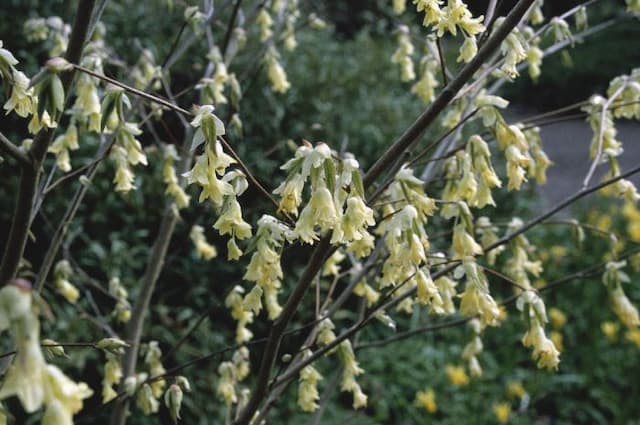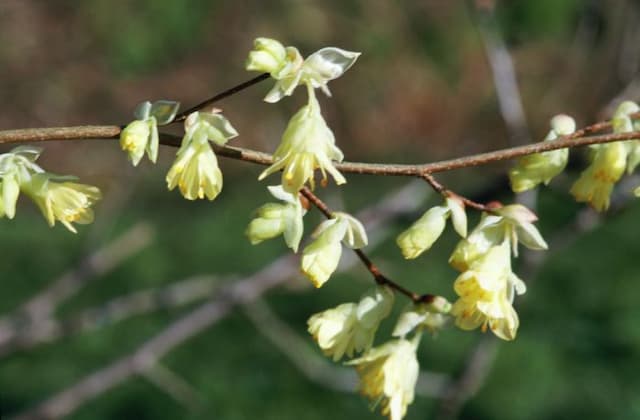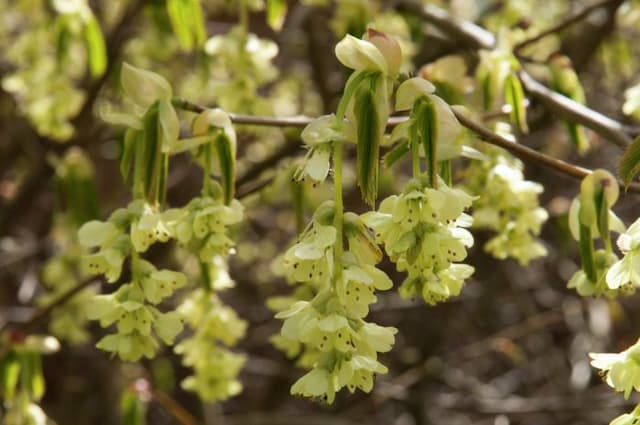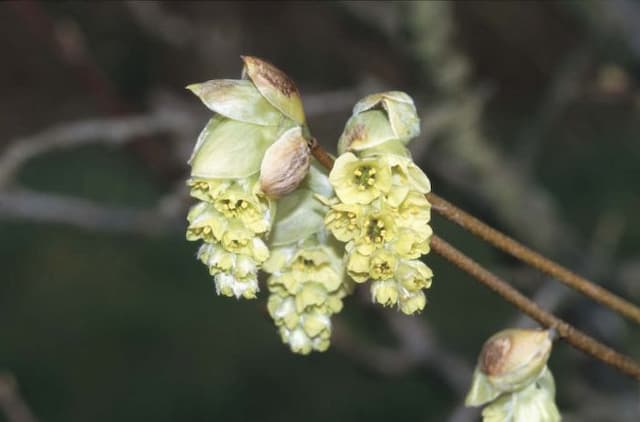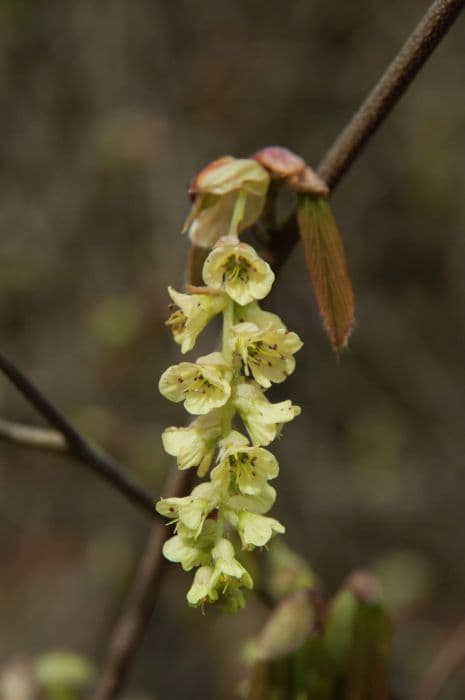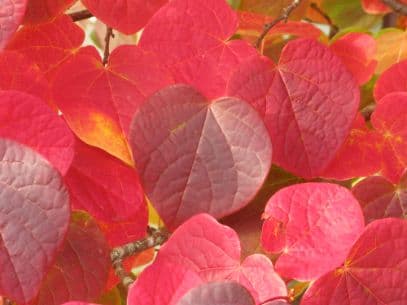Chinese Sweet Gum Liquidambar acalycina 'Burgundy Flush'

ABOUT
Liquidambar acalycina 'Burgundy Flush', commonly known as Chinese sweetgum, is a visually striking plant. It boasts unique leaves that resemble stars with pointed lobes. When new foliage emerges in spring, it is typically a deep burgundy color, hence the cultivar name 'Burgundy Flush'. As the season progresses, these leaves mature to a greenish shade with undertones of the original burgundy hue, creating a beautiful contrast. In autumn, the foliage undergoes another dramatic change, presenting a vivid display of reds, purples, and oranges before the leaves eventually fall off. The bark of the Chinese sweetgum is also noteworthy, with a rich texture that adds to its ornamental appeal throughout the year. Flowers and fruit of the Chinese sweetgum are less conspicuous, but the spiky, globe-shaped seed capsules do add an interesting visual element to the plant in the fall and winter. Overall, the 'Burgundy Flush' stands out for its seasonal foliage color changes and distinctive star-shaped leaves.
About this plant
 Names
NamesFamily
Altingiaceae
Synonyms
Chinese Sweet Gum, Burgundy Flush Sweet Gum
Common names
Liquidambar acalycina 'Burgundy Flush'.
 Toxicity
ToxicityTo humans
The Chinese Sweetgum is generally not considered toxic to humans. There are no well-documented cases of poisoning or toxic reactions from the plant. However, as with many plants, individual sensitivities can vary, and it is always a good practice to avoid ingesting parts of ornamental plants due to the potential for unknown allergies or reactions.
To pets
The Chinese Sweetgum is not commonly listed as a toxic plant to pets such as dogs and cats. There is no significant evidence to suggest that pets would experience poisoning from ingesting parts of this plant. Nevertheless, to be cautious, pet owners should discourage their animals from chewing on ornamental plants, as individual animals might have unique sensitivities or could experience gastrointestinal discomfort from ingesting plant material they are not accustomed to.
 Characteristics
CharacteristicsLife cycle
Perennials
Foliage type
Deciduous
Color of leaves
Burgundy
Height
20-25 feet (6-7.6 meters)
Spread
15-20 feet (4.5-6 meters)
Plant type
Tree
Hardiness zones
6-9
Native area
China
Benefits
 General Benefits
General Benefits- Aesthetic Appeal: Adds striking visual interest to landscapes with its deep burgundy-red foliage and distinctive pyramid-shaped canopy.
- Seasonal Interest: Offers year-round interest with changing leaf colors throughout the seasons, and attractive star-shaped fruit adding winter interest.
- Drought Tolerance: Once established, it has a good resistance to drought, which is beneficial in areas with water-use restrictions or low rainfall.
- Wildlife Attraction: The tree can attract various forms of wildlife, including birds and butterflies, which feed on its fruit and nectar.
- Shade Provider: Grows to a good size that offers ample shade, making it an excellent choice for parks, gardens, and residential areas.
- Urban Tolerance: Exhibits a tolerance to urban pollution, making it suitable for city environments and roadside plantings.
- Minimal Care: Requires relatively low maintenance once established, which is ideal for those looking for a low-effort landscape feature.
 Medical Properties
Medical PropertiesThis plant is not used for medical purposes.
 Air-purifying Qualities
Air-purifying QualitiesThis plant is not specifically known for air purifying qualities.
 Other Uses
Other Uses- Liquidambar acalycina 'Burgundy Flush', also known as Chinese sweet gum, can be used in woodworking and cabinetry due to its hardwood properties and attractive grain, making it desirable for decorative pieces.
- The resin from Chinese sweet gum can be used in the manufacturing of adhesives and lacquers, providing a natural binding agent for various applications.
- Chinese sweet gum's dried seedpods are sometimes used in crafts or as natural decorations, especially in wreaths and dried flower arrangements.
- The wood shavings of Chinese sweet gum can be utilized as garden mulch, providing both a protective layer for soil and an aesthetic ground cover.
- Leaves of Chinese sweet gum can be used to create natural dyes for fabric, yielding various shades of brown or green depending on the mordant used.
- In artistic practices, the branches and burls of Chinese sweet gum might be sought after by sculptors looking for unique wood patterns and forms.
- The tannins present in the bark of Chinese sweet gum trees may serve as a natural water clarifying agent for ponds and water gardens, helping to reduce algae growth.
- Chinese sweet gum, with its dense canopy, can be planted as a windbreak or to reduce noise pollution in urban areas.
- Throughout the fall, the vivid foliage of Chinese sweet gum makes it an excellent candidate for ornamental photography, drawing photographers who aim to capture the beauty of the changing seasons.
- As a relatively large tree at maturity, Chinese sweet gum can be planted to create shaded areas in parks and large gardens, providing cool spots for relaxation during hot weather.
Interesting Facts
 Feng Shui
Feng ShuiThe plant Chinese Sweetgum is not used in Feng Shui practice.
 Zodiac Sign Compitability
Zodiac Sign CompitabilityThe plant Chinese Sweetgum is not used in astrology practice.
 Plant Symbolism
Plant Symbolism- Beauty: With its attractive burgundy-red foliage, the Chinese sweet gum is often associated with natural beauty and the changing seasons.
- Change: As a deciduous tree whose leaves change color with the seasons, the Chinese sweet gum is symbolic of change and transition.
- Endurance: The hardiness of the Chinese sweet gum, capable of withstanding various conditions, can represent endurance and adaptability.
- Uniqueness: The distinctive star-shaped leaves and spiky fruit of the Chinese sweet gum signify uniqueness and individuality.
 Water
WaterChinese Sweetgum 'Burgundy Flush' should be watered deeply once a week, allowing the soil to dry out partially between watering sessions. During the active growing season in spring and summer, increase watering frequency to support growth, providing about 1 to 1.5 gallons of water each time, depending on the size and maturity of the plant. In the fall and winter, reduce the amount to once every two weeks as the plant enters dormancy. Always adjust watering based on rainfall and climate conditions to avoid waterlogging, which can lead to root rot.
 Light
LightThe Chinese Sweetgum 'Burgundy Flush' thrives best in full sun to partial shade. Ideally, it should receive at least 4-6 hours of direct sunlight daily. Choose a spot in the garden that gets ample morning sun with some afternoon shade in hotter climates to prevent leaf scorch.
 Temperature
TemperatureThe Chinese Sweetgum 'Burgundy Flush' does well in a wide range of temperatures but prefers a climate where the temperature is consistently between 50°F and 90°F. It can tolerate minimum temperatures down to around 0°F. To minimize frost damage, avoid placing it in locations where it would be exposed to cold winter winds.
 Pruning
PruningPrune the Chinese Sweetgum 'Burgundy Flush' in late winter or early spring before new growth starts to remove any damaged or diseased limbs. Light pruning can also be done in summer to shape the tree or to maintain a desired size. Pruning helps improve air circulation and light penetration, which encourages healthy growth.
 Cleaning
CleaningAs needed
 Soil
SoilChinese Sweet Gum 'Burgundy Flush' thrives in well-draining, fertile soil with a pH range of 5.5 to 7.5. A good mix might include loamy garden soil, compost, and perlite or sand to improve drainage. Regularly check the pH to maintain the optimal range for plant health.
 Repotting
RepottingChinese Sweet Gum 'Burgundy Flush' should generally be repotted every 2 to 3 years. As it is a slower-growing tree, it may not require frequent repotting. Choose a pot that is slightly larger than the current one and repot in the spring.
 Humidity & Misting
Humidity & MistingChinese Sweet Gum 'Burgundy Flush' prefers moderate to high humidity levels. It will thrive if the surrounding humidity stays around 50-60%. Avoid placing it in very dry environments without supplemental humidity.
 Suitable locations
Suitable locationsIndoor
Provide bright, indirect light and avoid dry air.
Outdoor
Plant in a sunny spot, shelter from strong winds.
Hardiness zone
7-9 USDA
 Life cycle
Life cycleThe life of Liquidambar acalycina 'Burgundy Flush', commonly known as Chinese Sweet Gum, begins with seed germination, which is influenced by environmental conditions like temperature and moisture. After germination, the seedling stage is characterized by the emergence of the plant's initial roots and leaves, growing slowly as it establishes a steady footing. The plant then enters the vegetative stage, where it experiences rapid growth and leaf expansion, developing its distinctive burgundy flushed foliage during this time. Following vegetative growth, the Chinese Sweet Gum reaches maturity, with the capability to flower and produce fruits—spiky capsules that contain seeds for reproduction. Annually, once mature, it undergoes a reproductive cycle, usually in the spring, when it produces inconspicuous flowers followed by fruit set. Finally, the plant enters a period of senescence in its later years, where growth slows, and it may become more susceptible to environmental stresses, pests, and diseases before eventually dying.
 Propogation
PropogationPropogation time
Spring-Summer
The most popular method of propagating Chinese Sweet Gum 'Burgundy Flush' is through softwood cuttings. This technique involves taking a cutting of about 4-6 inches (10-15 cm) in length from new growth that is not yet hard or fully matured, usually in late spring or early summer. The bottom end of the cutting should be treated with a rooting hormone to encourage root development and then planted in a well-draining soil mix. It's beneficial to create a humid environment by covering the cutting with a plastic bag or placing it in a propagator, ensuring that the soil remains moist but not waterlogged. Cuttings typically root in a few weeks, after which they can gradually be acclimatized to outdoor conditions before planting out in their permanent location.
